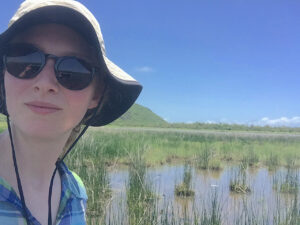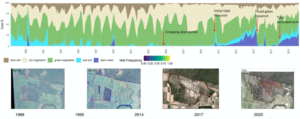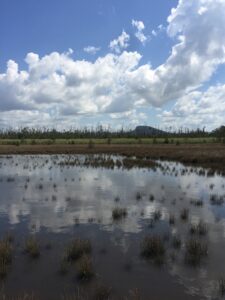A Griffith University study found that wetland vegetation will naturally re-establish on abandoned agricultural land threatened by sea level rise.
Published in Restoration Ecology, the study assessed the potential for abandoned agricultural land in Southeast Queensland to naturally regenerate into supratidal wetlands (those above the tidal line) under conditions that simulate sea level rise, by reinstating the tidal flow to the area.
“We discovered that the wetland vegetation can recover after agricultural abandonment in favourable conditions where there was no tidal water,” said lead author Dr Rebekah Grieger, a research fellow at the Australian Rivers Institute, “but when tides were re-introduced the vegetation suffered.”

Lead author Dr Rebekah Grieger, a research fellow at the Australian Rivers Institute
With sea level predicted to rise, the structure and type of trees/plants that make up wetlands above the tidal range is likely to change as they become inundated with saltwater.
“These changes could provide some unique opportunities for the restoration of adjacent agricultural land,” Dr Grieger said.
“Regeneration of coastal wetland vegetation on abandoned sugarcane cropland, specifically through tidal reinstatement, provides important opportunities to evaluate the ecological outcomes of this management approach and explore impacts of projected climate change.”
Coastal wetlands are among the most economically and environmentally important ecosystems globally, providing ecological services such as improving water quality, providing habitat, carbon sequestration, and storm buffering.
However, coastal ecosystems are facing global decline from a host of ongoing threats, with wetlands modified for agriculture and horticulture, destroying their structure and function and replacing it with economically productive systems.
“In tropical and subtropical coastal regions sugarcane cropping has led to widespread clearing of coastal vegetation, the leveling of the landscape, and construction of drainage channels with flood gates to control water levels,” Dr Grieger said.
“So, the restoration of abandoned agricultural lands provides us with a great important opportunity to reestablish lost wetland ecosystems and the services they provide like carbon sequestration, water quality improvement, and weed management.”
“Our goal was to better understand the ability for wetlands to naturally regenerate after the cessation of sugarcane farming and how coastal wetlands in subtropical southeast Queensland respond to the sudden and permanent changes to tidal inundation, likely to occur as a long term outcome of sea level rise.”
To investigate this ability to naturally regenerate the researchers assessed an area of agricultural land, previously used for sugar cane cultivation, that had been abandoned for a decade and a half. Supratidal wetlands, that are generally exposed to low salt levels, are highly vulnerable to climate change and the associated sea level rise.

Hydrological changes at Yandina Creek Wetlands, showing water, vegetation, and soil cover (top) and historical satellite imagery showing clearing (1988), sugarcane farming (1995), abandonment (2017), and restoration (2020) over time (Bottom: QImagery)
“In the 15 years since crop abandonment, distinct communities of typical supratidal wetland vegetation have naturally re-established, in predominately freshwater conditions, with minimal management intervention,” Dr Grieger said.
“Reinstating natural tidal flows to degraded wetlands and agricultural lowlands which in the past were naturally exposed to tidal fluctuations, increased the flooding of this area with brackish water and triggered some strong responses of vegetation.”

Yandina Creek Wetlands, photo credit: Rebekah Grieger
As salinity is a key driver of vegetation composition the current state of supratidal wetlands with relatively low salinity can be threatened by saline water inundation, as such, despite benefits of restoring tidal wetland environments, this approach could impact on freshwater biota sensitive to salty flood waters.
“We found that restoration through reinstatement of tidal flows effected these vegetation communities through reduced understory diversity and coverage,” Dr Grieger said.
Passive wetland restoration relies on germination from in situ soil seed banks and local water-mediated dispersal, however, past agricultural land use can reduce the abundance and viability of seeds stored in the soil.
The researchers found that while tidal reinstatement reduced the germination capacity of non-salt tolerant species, soil seed banks do not only reflect the current standing vegetation communities but provide a store of species which represent a range of potential vegetation types that can establish under changed conditions, indicating potential future vegetation transitions.
“Tree communities appeared resilient to tidal reinstatement in the short term and may persist for some time yet, however, salt-tolerant understorey species spread under tidal reinstatement conditions,” Dr Grieger said.
“Following the removal of flood gates, species richness and understory vegetation cover generally decrease, except in marsh plots, where salt-tolerant species increased throughout.
“While supratidal wetland vegetation can re-establish on abandoned farmland with minimal management interventions and little need to actively replant these landscapes, the increased saltwater flooding, likely to occur long-term sea level rise, puts these communities at risk of transitioning to salt-tolerant vegetation, with reduced species richness, plant abundance, productivity, and regeneration.”


